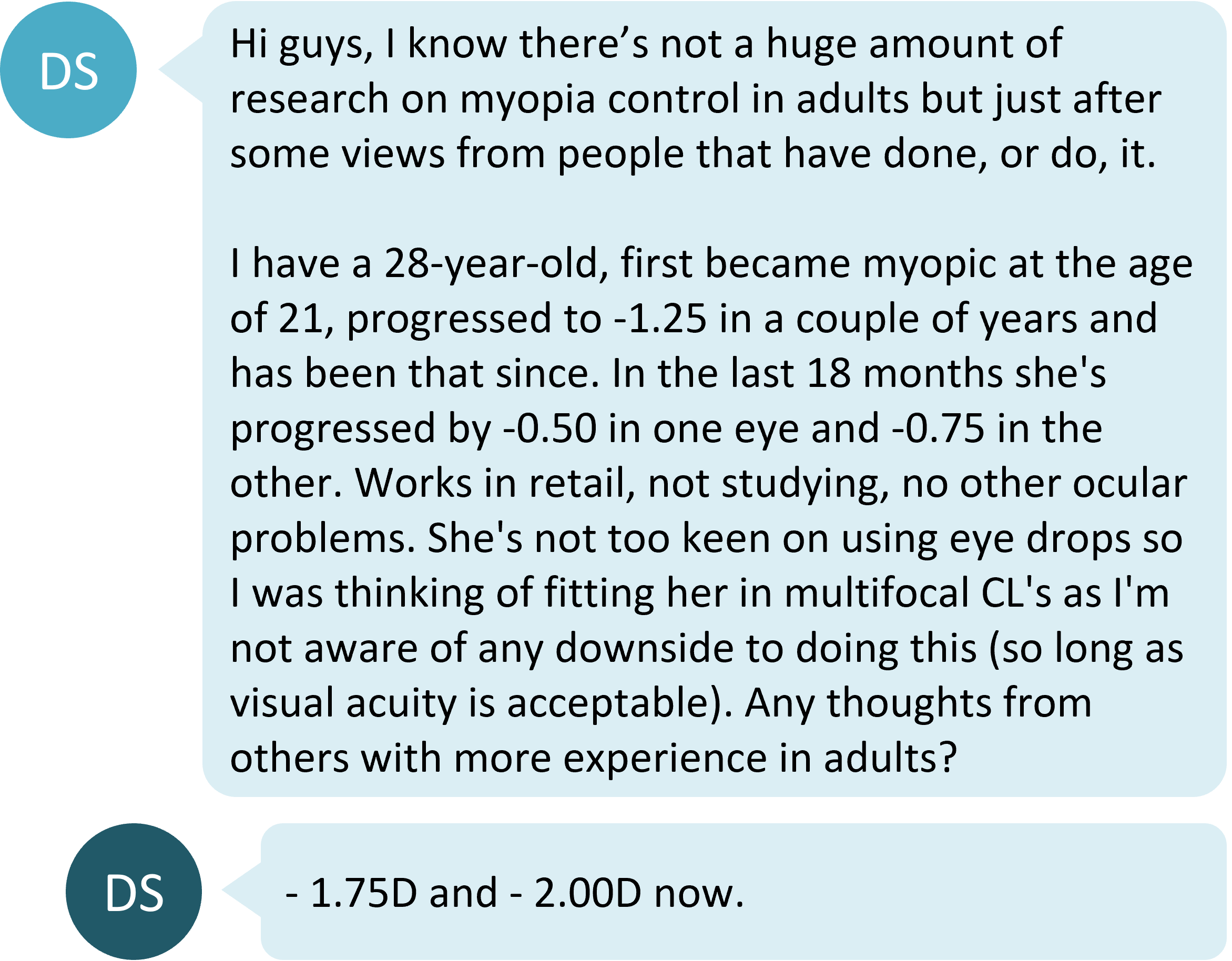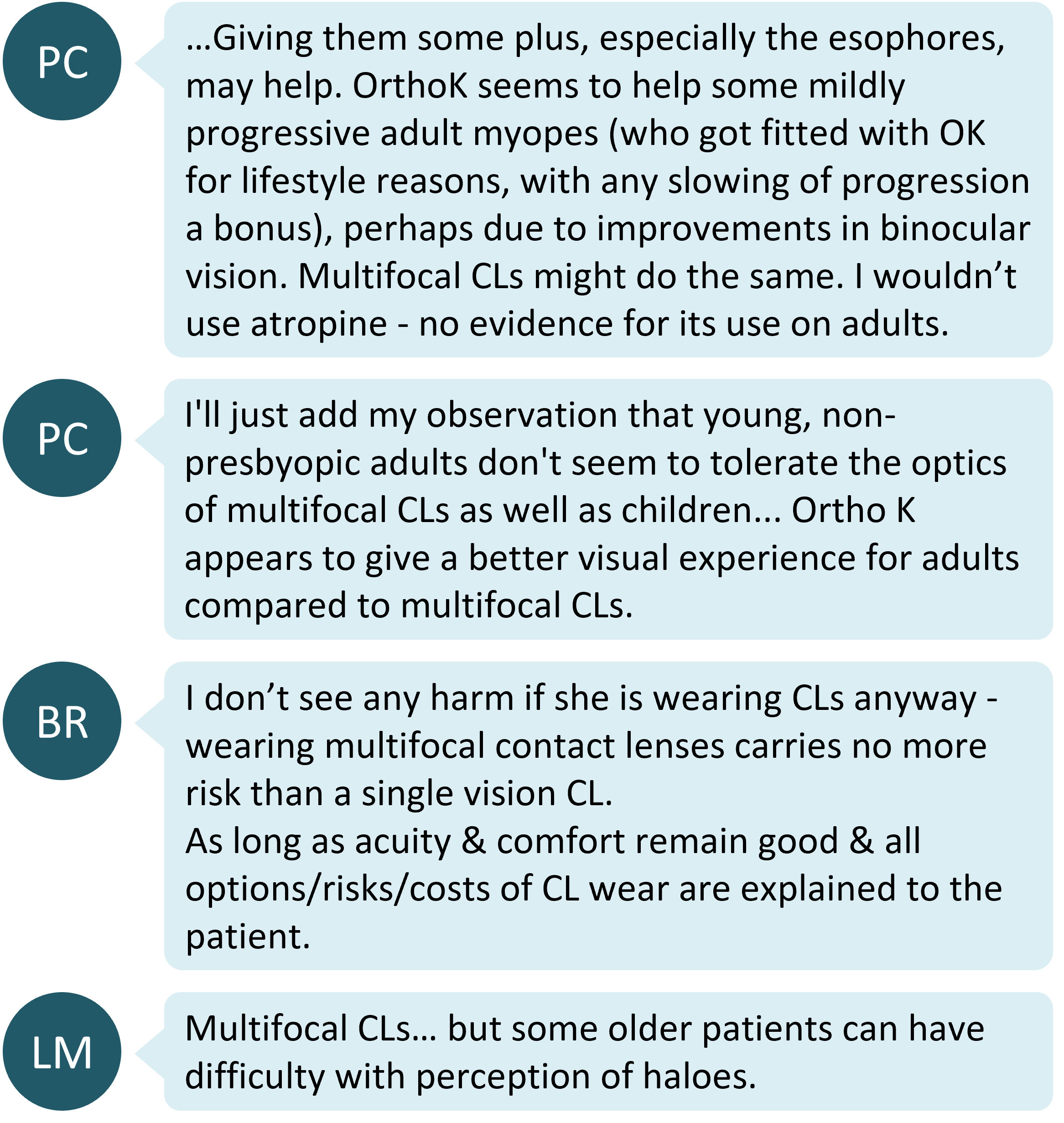Myopia onset typically occurs in childhood, but adult-onset myopia also occurs in clinical practice. While increased near tasks and reduced outdoor time can be risk factors for myopia onset in children, there is a stronger link between near work and myopia onset in adults. In this case, DS is interested in some advice from the Myopia Profile Facebook community on the options for myopia control in adult-onset myopia.

Adult-onset myopia
A person whose myopia manifests during adulthood (18 years old or older) is referred to as adult onset myope. Onal et al showed that 14.7% of myopic cases amongst Turkish medical student were adult-onset1, whilst Iribarren et al showed almost half of myopic office workers had shown onset after age of 21.2
Adult-onset myopes usually have low to moderate myopia.3 In a group of young adult clinical microscopists, 40% showed a myopic shift over two years, attributed to an increase in vitreous chamber depth with no change in corneal curvature, anterior chamber depth or lens thickness.4 One study also found that there could be a genetic contribution in adult-onset myopia.5
The risk factors for adult myopia onset and progression appear to be prolonged near work with short working distances, high AC/A ratio and high accommodative lag.7,8 Jiang et al found that there a link between high AC/A ratio with adult onset myopia.9 There have been no studies on this in adults, but in children an increased accommodative lag is hypothesized to generate hyperopic defocus and hence influence axial elongation.10
Measuring axial length is important to understand ocular disease risk. Whilst there may or may not be changes in axial length in adult myopia, understanding the individual patient's axial length measurement helps to guide their ocular health management. Axial lengths over 26mm indicate high myopia and increased lifelong risk of pathology and vision impairment,11 requiring annual retinal health review.12
Measuring the corneal curvature is important to rule out any refractive changes owing to steepening corneal changes. Read more about this in Are you measuring the cornea in myopia management? The commenters mentioned their observations of axial length and adult myopia progression rates. The data cited by commenter MB is from the following research abstract.

Myopia control options
Studies on myopia control efficacy in adult-onset progressive myopia - or myopia progression in adulthood - are limited when compared to studies done in children. Contact lens myopia control options were highly recommended by the commenters. There are two small studies indicating orthokeratology's ability to slow progression in adult myopes but neither had control groups.13,14

Based on PC’s personal observation, young adults tended to struggle adapting to multifocal soft contact lenses due to optical disturbances (e.g. halos and glare) more so than children. Kang et al showed low and high add multifocal contact lenses affected low contrast visual acuity in young adults.15 While a direct comparison between multifocal contact lens acuity and that achieved with orthokeratology (OK) has not been undertaken, one study has shown no impact of OK on visual acuity or visual performance in young adults.16
There is no longitudinal research on the role of low-concentration atropine for myopia control in adult populations. Kaymak et al studied the short-term effects of low-concentration atropine in young adults.17 After 0.01% atropine instillation the prior night, pupil dilation of around 1.5mm and reduced near point of accommodation by at least 1D was noted in both morning and afternoon. Therefore, it is possible that low-concentration atropine may be less tolerated by adults compared to children.
What about the visual environment?
The case mentions that the patient does not have an intensive screen-based job and is not studying. Since adult-onset myopia is linked to both binocular vision disorders and close viewing distances, measurement of the former and providing advice on the latter are also important for this patient. Perhaps her retail work time doesn't involve much screen work but her leisure time does - according to a 2021 survey, over half of US-based adults report spending at least 5 hours per day on their smartphones, not including any work-related smartphone use. Taking regular breaks and maintaining a reasonable viewing distance with smartphone use is important advice for all young adult myopes.
Take home messages
- Adult-onset myopia is typically associated with intense near work at short viewing distances, high AC/A ratio and high accommodation lag. Visual environment advice is important for all adult myopes.
- Research on adult myopia control options is limited. This is an important point to communicate to patients when considering options to correct myopia and potentially slow progression as well.
- Measurement of the corneal curvature to rule out pathology, and measurement of axial length to understand ocular disease risk, facilitate best-practice management of the adult-onset myope.
Further reading on adult myopia

About Kimberley
Kimberley Ngu is a clinical optometrist from Perth, Australia, with experience in patient education programs, having practiced in both Australia and Singapore.

About Connie
Connie Gan is a clinical optometrist from Kedah, Malaysia, who provides comprehensive vision care for children and runs the myopia management service in her clinical practice.
This content is brought to you thanks to an unrestricted educational grant from

References
- Onal S, Toker E, Akingol Z, Arslan G, Ertan S, Turan C, Kaplan O. Refractive errors of medical students in Turkey: one year follow-up of refraction and biometry. Optom Vis Sci. 2007 Mar 1;84(3):175-80. (link)
- Iribarren R, Cerrella MR, Armesto A, Iribarren G, Fornaciari A. Age of lens use onset in a myopic sample of office-workers. Current Eye Res. 2004 Jan 1;28(3):175-80. (link)
- Fledelius HC. Adult onset myopia‐oculometric features. Acta Ophthalmologica Scandinavica. 1995 Oct;73(5):397-401. (link)
- McBrien NA, Adams DW. A longitudinal investigation of adult-onset and adult-progression of myopia in an occupational group. Refractive and biometric findings. Invest Ophthalmol Vis Sci. 1997 Feb 1;38(2):321-33. (link)
- Dirani M, Shekar SN, Baird PN. Adult-onset myopia: the Genes in Myopia (GEM) twin study. Invest Ophthalmol Vis Sci. 2008 Aug 1;49(8):3324-7. (link)
- Grosvenor T. Refractive component changes in adult‐onset myopia: evidence from five studies. Clin Exp Optom. 1994 Sep;77(5):196-205. (link)
- Bullimore MA, Reuter KS, Jones LA, Mitchell GL, Zoz J, Rah MJ. The Study of Progression of Adult Nearsightedness (SPAN): design and baseline characteristics. Optom Vis Sci. 2006 Aug;83(8):594. (link)
- Jiang BC, Morse SE. Oculomotor functions and late-onset myopia. Ophthalmic and Physiological Optics. 1999 Mar 1;19(2):165-72. (link)
- Jiang BC. Parameters of accommodative and vergence systems and the development of late-onset myopia. Invest Ophthalmol Vis Sci. 1995 Jul 1;36(8):1737-42. (link)
- Mutti DO, Sinnott LT, Mitchell GL, Jones-Jordan LA, Moeschberger ML, Cotter SA, Kleinstein RN, Manny RE, Twelker JD, Zadnik K, CLEERE Study Group. Relative peripheral refractive error and the risk of onset and progression of myopia in children. Invest Ophthalmol Vis Sci. 2011 Jan 1;52(1):199-205. (link)
- Tideman JW, Snabel MC, Tedja MS, van Rijn GA, Wong KT, Kuijpers RW, Vingerling JR, Hofman A, Buitendijk GH, Keunen JE, Boon CJ, Geerards AJ, Luyten GP, Verhoeven VJ, Klaver CC. Association of Axial Length With Risk of Uncorrectable Visual Impairment for Europeans With Myopia. JAMA Ophthalmol. 2016;134(12):1355-1363. (link)[Link to Myopia Profile Science Review]
- Gifford KL, Richdale K, Kang P, Aller TA, Lam CS, Liu YM, Michaud L, Mulder J, Orr JB, Rose KA, Saunders KJ, Seidel D, Tideman JWL, Sankaridurg P. IMI - Clinical Management Guidelines Report. Invest Ophthalmol Vis Sci. 2019 Feb 28;60(3):M184-M203. (link)
- Gifford KL, Gifford P, Hendicott PL, Schmid KL. Zone of Clear Single Binocular Vision in Myopic Orthokeratology. Eye Contact Lens. 2020 Mar;46(2):82-90. (link)
- González-Méijome JM, Carracedo G, Lopes-Ferreira D, Faria-Ribeiro MA, Peixoto-de-Matos SC, Queirós A. Stabilization in early adult-onset myopia with corneal refractive therapy. Cont Lens Anterior Eye. 2016 Feb;39(1):72-7. (link)
- Kang P, McAlinden C, Wildsoet CF. Effects of multifocal soft contact lenses used to slow myopia progression on quality of vision in young adults. Acta Ophthalmol. 2017 Feb;95(1):e43-53. (link)
- Johnson KL, Carney LG, Mountford JA, Collins MJ, Cluff S, Collins PK. Visual performance after overnight orthokeratology. Cont Lens Anterior Eye. 2007 Mar;30(1):29-36. (link)
- Kaymak H, Fricke A, Mauritz Y, Löwinger A, Klabe K, Breyer D, Lagenbucher A, Seitz B, Schaeffel F. Short-term effects of low-concentration atropine eye drops on pupil size and accommodation in young adult subjects. Graefe's Arch Clin Exp Ophthalmol. 2018 Nov;256(11):2211-7. (link)











